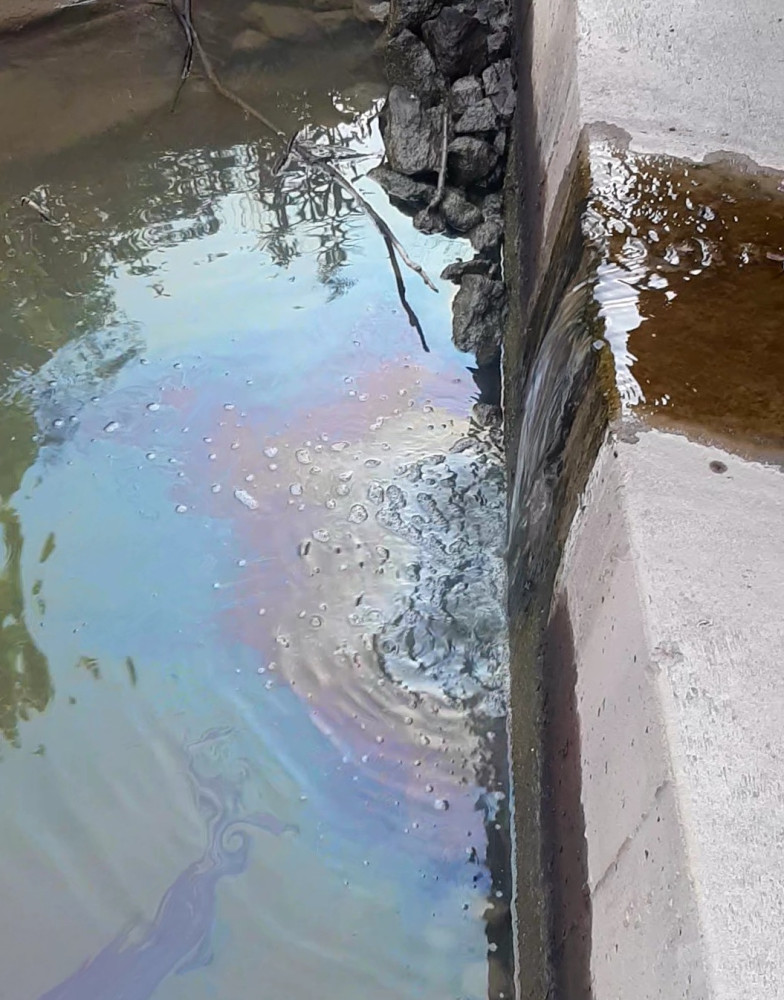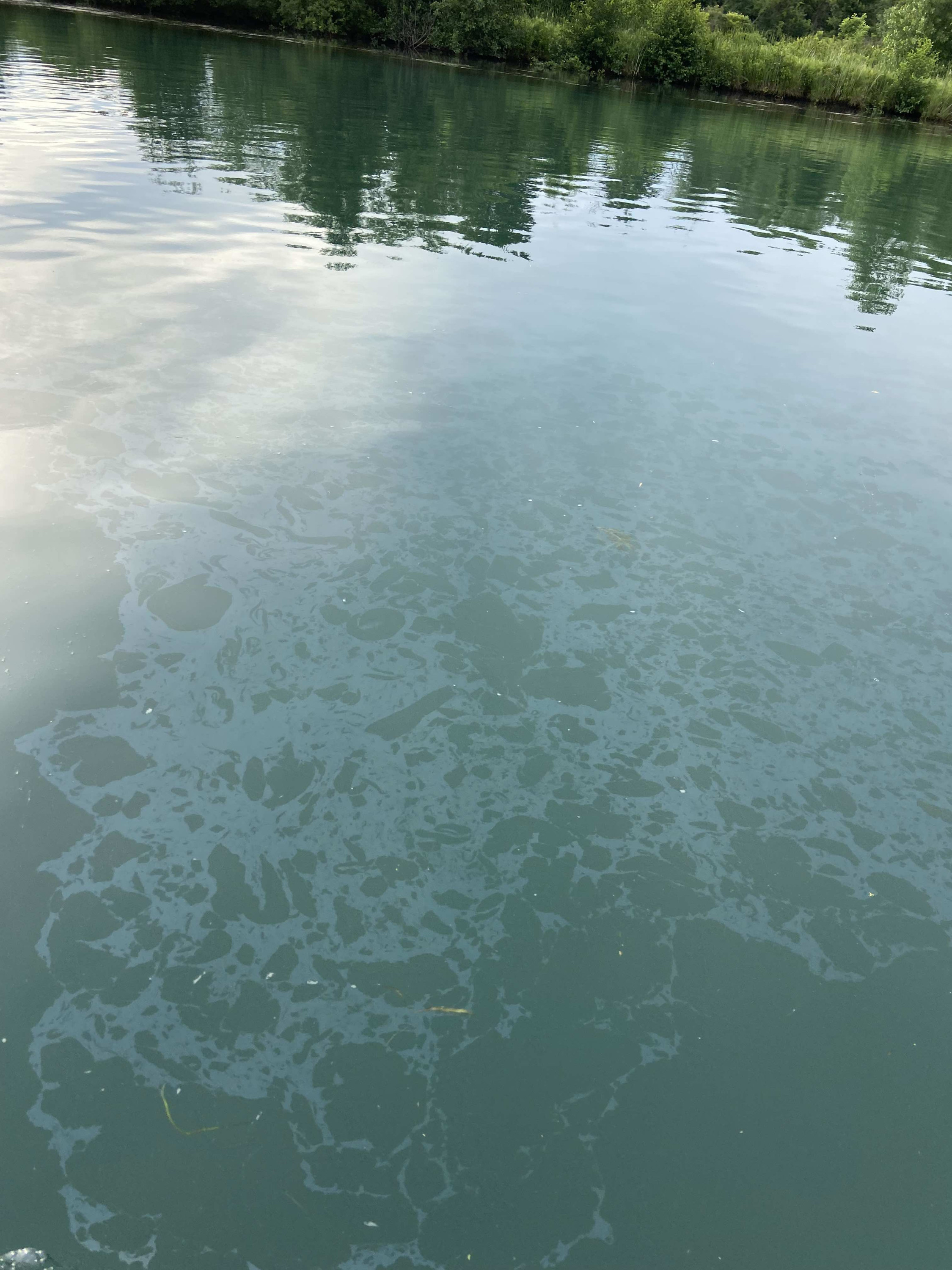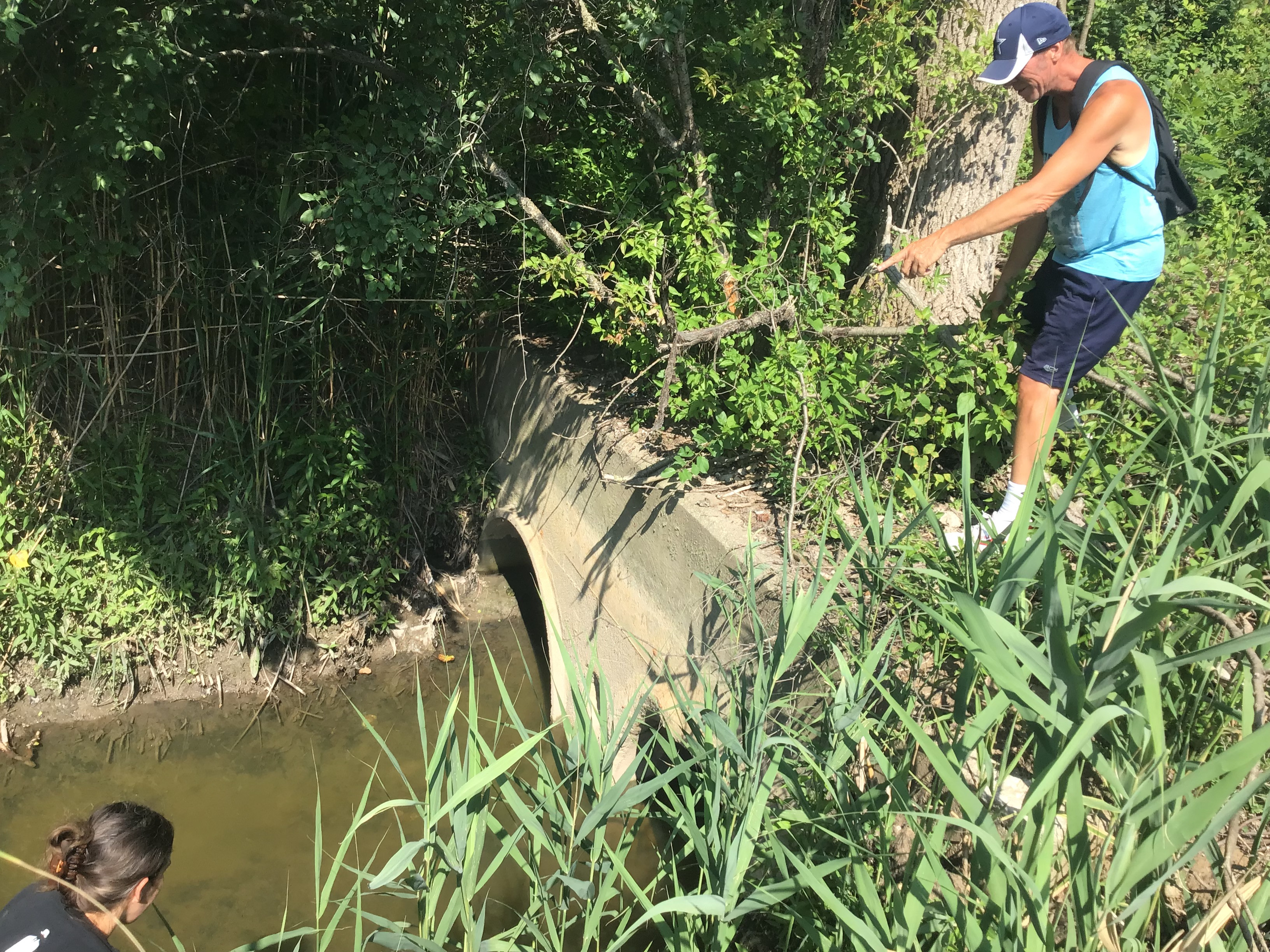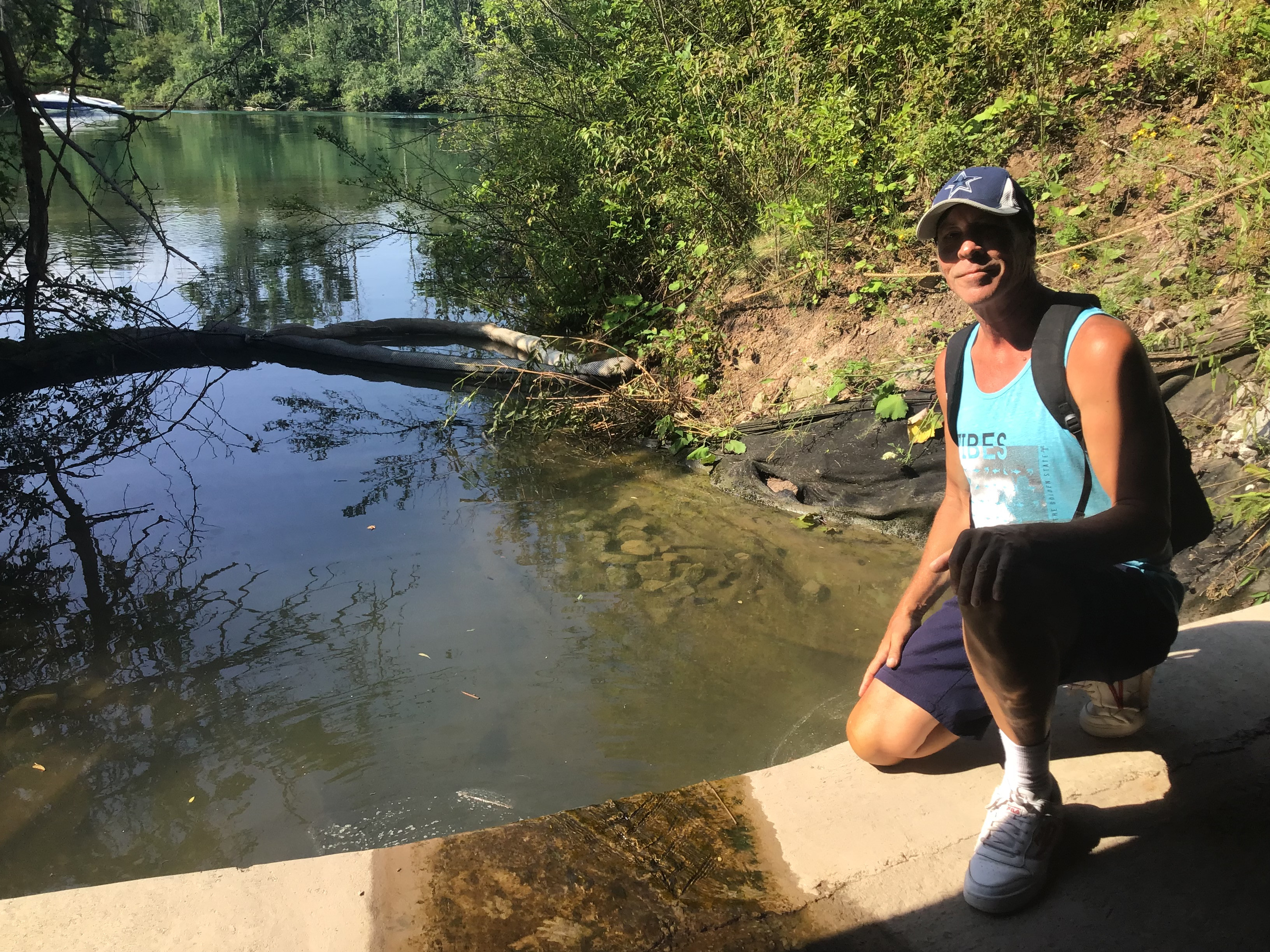
Niagara residents force Environment Ministry to act after oil slick discovered on Welland River
“I could smell it long before I reached the site, a powerful smell of oil.”
That’s how Niagara Falls resident Mike Cushman described a toxic rainbow sheen that appeared on the Welland River earlier this month.
Cushman was not the first to discover what appeared to be an oil spill. He was alerted by the online posts of fellow resident Sarah Ward and hopped on his bicycle to verify it for himself.
The two Niagara Falls residents are well known locally in the field of environmental activism and have collaborated on many issues in the past.
Ward says she was alerted to the spill by Janet Krowchuk, a friend and frequent boater on the Welland River.
Krowchuk and Ward filed separate reports to the Ministry of the Environment, Conservation and Parks (MECP) through its complaint hotline on July 2, and by the next morning Ministry employees were on the site to investigate.

A sheen of oil was spotted by residents on the Welland River at the beginning of July.
(Janet Krowchuk)
“The Ministry takes all threats to the environment very seriously and provides timely services for receiving, assessing and coordinating responses to reports of pollution and spills through the 24/7 operations of a Spills Action Centre,” MECP spokesperson Lindsay Davidson states.
After their initial visit, the Ministry staff concluded that if there was a leak somewhere along the river, it could be intermittent in nature; they also suggested the source could have been a boater being careless with fuel, or any number of people being irresponsible with petroleum products. Whatever it was, it appeared to be dissipating.
Cushman and Ward were not convinced.

Mike Cushman and Sarah Ward trace the source of the oil leaking into the Welland River.
(Ed Smith/The Pointer)
Separately they returned to the site numerous times, taking photographs and videos and sending them to the Ministry. The unmistakable smell and rainbow sheen on the water were getting worse, and they refused to ignore it.
On Saturday July 6, Cushman took it upon himself to follow the clues as far upstream as he could. It had been 5 days since the spill was first recorded and the oily sheen was worsening. After 30 minutes of searching, he backtracked the flow as far as he could go. The oily substance appeared to be coming from a subterranean pipe south of Don Murie Street—an industrial area that houses a number of businesses that could be the source of the leak. He reported his findings to the Ministry.
Meanwhile, Ward was posting about the spill on a community news site and warned residents of the chemical leaking into the popular waterway. She felt it was especially important that the public should be aware, “so they are not swimming in the water where the chemical is present”. She continued to send the Ministry pictures and videos of the spill, growing more convinced daily that further action was required.
Responding to the photos and reports that continued to come in, and armed with Cushman’s discovery of the potential source, the MECP returned to the site on July 8 and what was described by the Ministry as a “gooey oily blob” was discovered. A hazardous material contractor was dispatched to the site. A large vacuum truck was used to suck up the substance and other surface contamination while an absorbent sock boom was placed at the outfall of the source pipe to hold back and absorb any residual matter moving towards the river.
The MECP reports that efforts to identify the spilled material and a potential source are ongoing. Interested members of the public may contact the local district office to follow-up on reported concerns, the Ministry stated, although they may not be able to provide information related to ongoing investigations.
The entire experience with the Ministry has left Cushman frustrated.
“If the Ministry is closed on weekends and nobody responds to a reported oil leak, who do we call, what do we do?”
He’s relieved that the Ministry now appears to be fully engaged in the clean up and tracking down the offender, but he feels it took too long. According to him this is the second time in a year this particular pipe, leading from the industrial area, has been a source of pollution into the Welland River. He would also like to know the ultimate outcome. Will the perpetrator be discovered and identified? Will fines be issued? Will the public be notified?

Resident Mike Cushman is frustrated by the lack of quick action on behalf of the environment ministry to address the oil spilling into the Welland River. A sock boom has now been placed to block further contamination.
(Ed Smith/The Pointer)
Sarah Ward is more measured in her response. She feels that the MECP is doing all that can be expected under the circumstances and that any shortcomings are a factor of limited resources. Informed by her background in chemical engineering technology and having worked in a variety of industrial fields, she outlines a need for better technology integration in the form of real time monitoring of spills, as well as a lack of sufficient policies to better detect these types of incidents.
Both of their views are in line with the findings of the Auditor General of Ontario. Among a long list of critiques aimed at the various environmental ministries, the AG noted in her 2021 report that the MECP does not conduct adequate regulatory activities to reduce the risk of the most common sources of spills impacting human health and the environment; the enforcement regime does not effectively ensure compliance with the regulations that do exist; the ministry does not disclose sufficient information to the public about the quantity of hazardous spills and the harm they cause; and they are not recovering costs from responding to spills, resulting in taxpayers—not the polluters—paying for the cleanup. She further noted that “the hazardous spill enforcement regime is not strong enough to bring entities into compliance in a timely manner or deter repeat violations.”
In her 2023 follow-up to the initial report, the auditor general noted that the MECP has chosen not to implement most of the recommendations contained in the initial report. The recommendations are intended to improve accountability and transparency with all stakeholders in Ontario.
In 2023/24 the MECP Spills Action Centre received 2,405 reports via the online portal and over 3,400 reports by phone. The number of complaints that resulted in action, investigations and/or charges was not made available.
Joceyln Baker is the Co-Chair of the Niagara River Binational Ramsar Designation Steering committee, a past project manager of the Niagara River Remedial Action Plan, and a professor of environmental sciences and according to her “environmental advocacy is an essential component of safeguarding all ecosystems”.
She points out that it was the public and a few key individuals that were responsible for getting the Niagara River on the radar for environmental protection more than 50 years ago. That advocacy has resulted in “one of the most degraded areas in the Great Lakes now being recognized as a globally important area for its biodiversity contributions including wildlife, wetlands, and water”.
Ward and Cushman don’t need to be convinced of the important role citizens play in protecting the environment. They are a consistent presence and vocal champions for anything that will better serve environmental protections throughout Niagara and know that the current system has many weak areas.
“Citizen science is a fundamental part of ensuring the sustainability of our natural environments. Individual actions and decisions matter. Don't let anyone convince you that they don't. Together they can add up and change the course of history,” Baker states.
Mike Cushman, Sarah Ward and Janet Krowchuk are proof of that.
How to report a spill:
MECP: https://report-pollution.ene.gov.on.ca/
24/7 telephone line: 1-866-663-8477 MOE-TIPS
Niagara Peninsula Conservation Authority (NPCA): [email protected]
905-788-3135
Crime Stoppers Tips: 1-800-222-TIPS (8477)
Email: [email protected]
At a time when vital public information is needed by everyone, The Pointer has taken down our paywall on all stories to ensure every resident of Brampton, Mississauga and Niagara has access to the facts. For those who are able, we encourage you to consider a subscription. This will help us report on important public interest issues the community needs to know about now more than ever. You can register for a 30-day free trial HERE. Thereafter, The Pointer will charge $10 a month and you can cancel any time right on the website. Thank you
Submit a correction about this story


